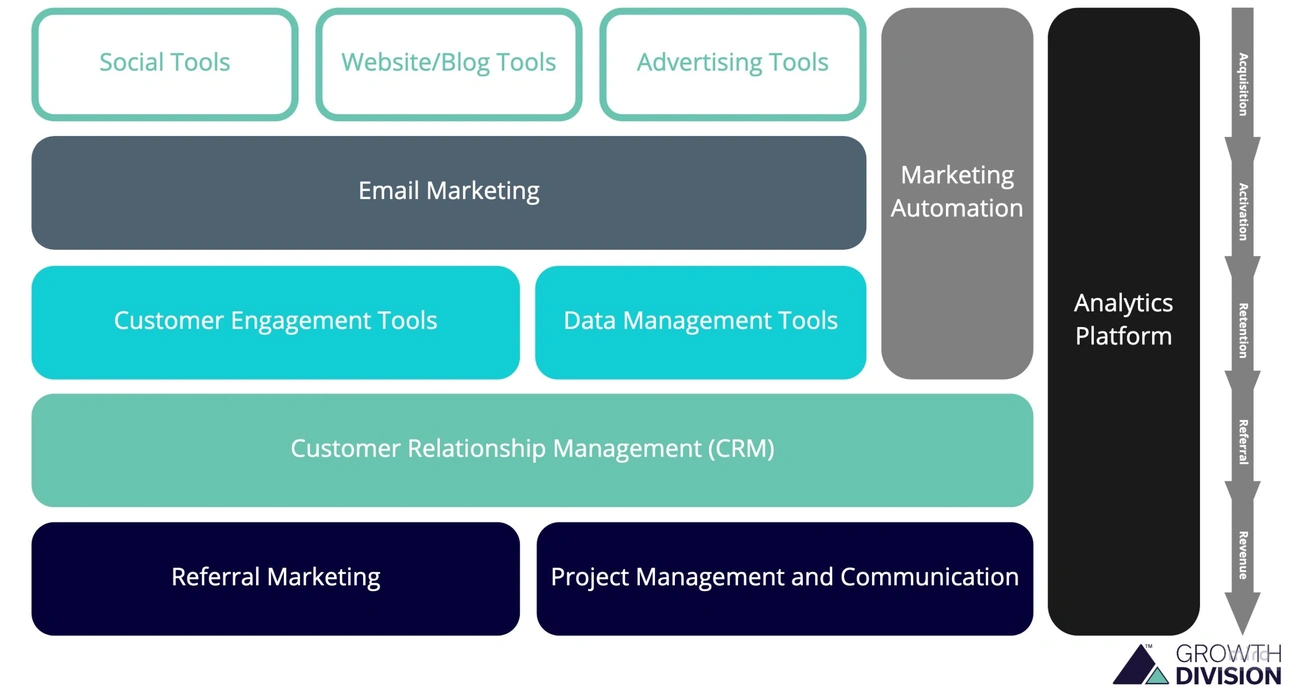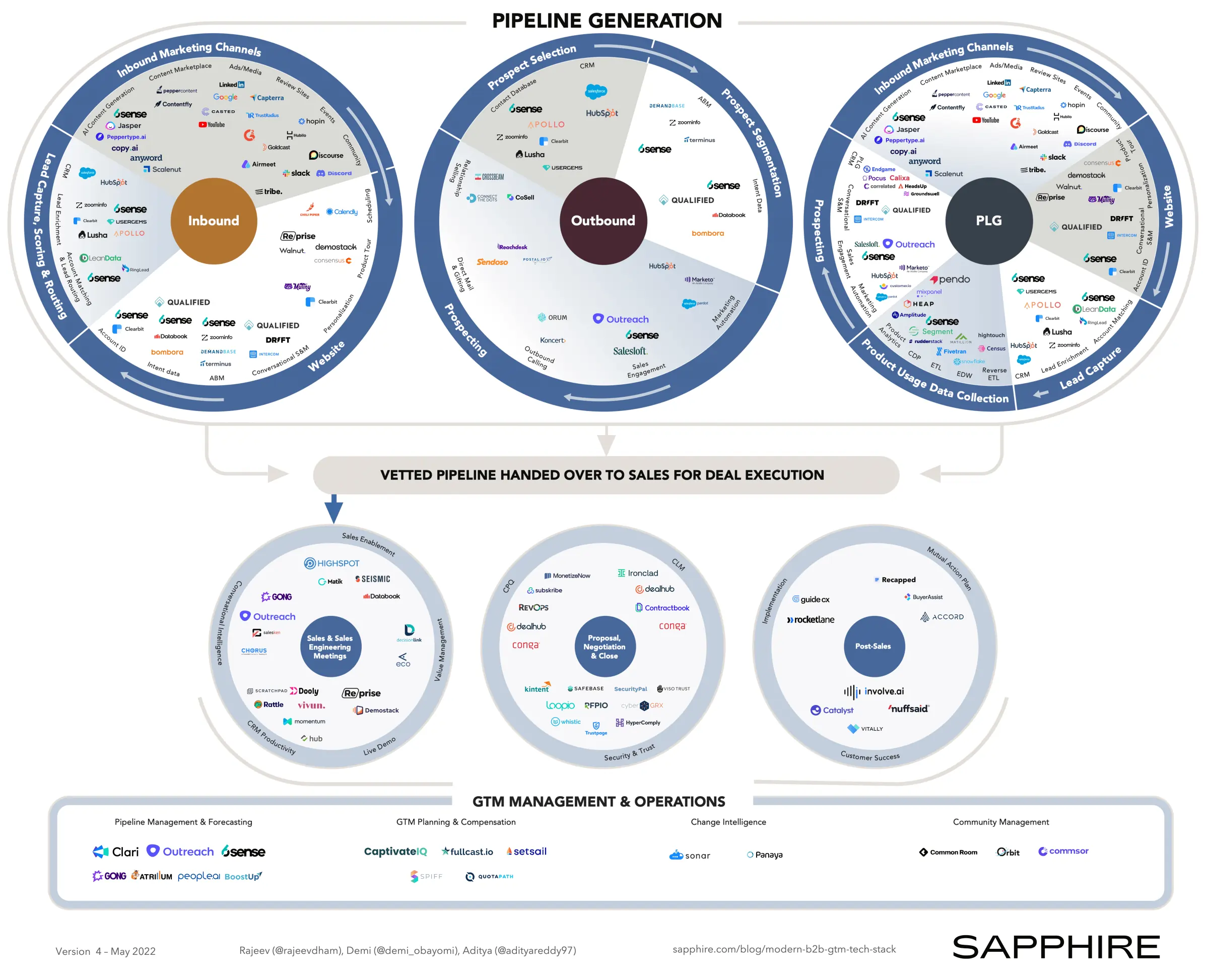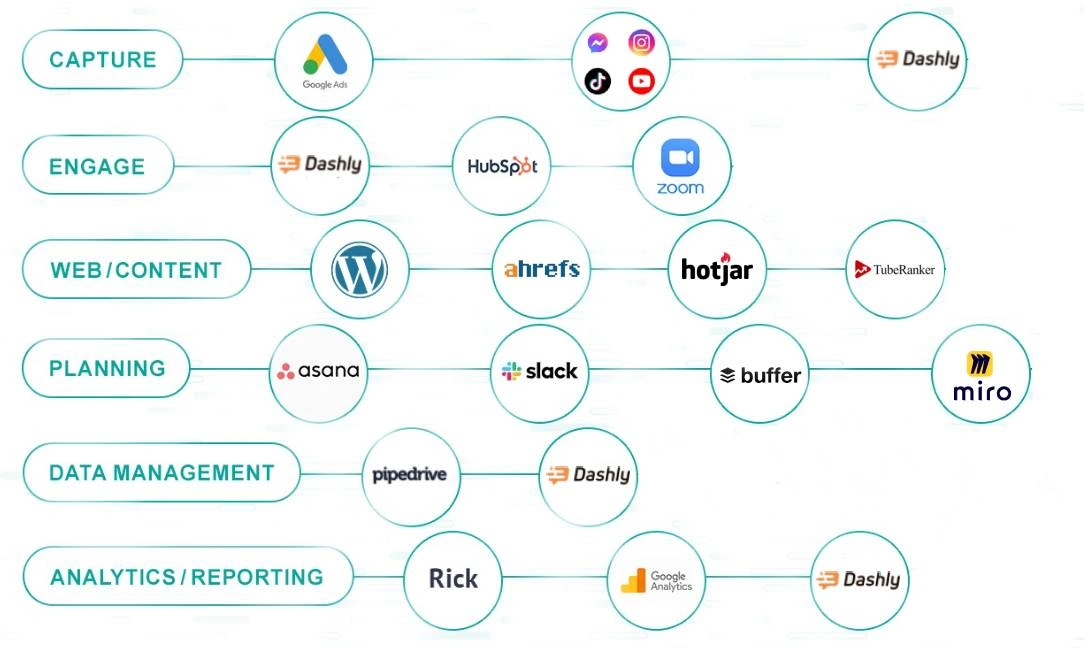A well-built B2B marketing tech stack works like a superpower for your business. Your connected ecosystem can deliver real results instead of wrestling with scattered tools and data silos.
Many companies spend too much on marketing technology but still struggle to identify tools they need to propel development. Building a tech stack that works starts with a clear, strategic vision for your marketing efforts. The combination of core platforms like CRM systems, marketing automation tools, and content management systems creates a foundation. This foundation optimizes operations, boosts customer relationships, and delivers measurable growth.
In this piece, you’ll learn to build a B2B marketing technology stack tailored for complex sales cycles. We’ll help you develop a marketing stack architecture that changes how you attract, nurture, and convert valuable B2B customers. Our focus includes picking the right tools based on proven criteria and creating simplified processes through proper integration.
What is a B2B Marketing Tech Stack?
A B2B marketing tech stack combines marketing technology tools, platforms, and software that work together. These tools streamline marketing processes, analyze data, and automate tasks. The stack isn’t just one solution – it’s a carefully picked group of technologies that power your entire marketing operation.
Marketing technology has expanded in today’s digital world. The number of marketing tools grew from 150 in 2011 to more than 11,000 by May 2023. This growth shows modern marketing’s complexity and the specialized tools needed for various challenges.
B2B companies with complex sales cycles use marketing tech stacks as their strategy’s engine. These stacks help tackle unique challenges B2B marketers face. The buying process involves multiple stakeholders and longer decision timelines.
A well-designed B2B marketing tech stack is different from its B2C counterpart. Both use technology to get customers, but B2B and B2C marketers use different channels and techniques based on their customer’s experience. B2B marketing focuses more on relationship management tools and tracks attribution through longer sales cycles.
Your marketing tech stack serves three main purposes:
- Streamline Internal Collaboration – Marketing, sales, and customer success teams can work better with shared data and insights
- Analyze Marketing campaign Performance – You can see what works, which efforts drive revenue, and where leads come from
- Conduct Personalized Communication – You can target relevant interactions with prospects throughout the customer lifecycle
A good B2B marketing tech stack frees your team from manual tasks naturally. Teams can focus on results instead of processes. The stack gives valuable customer insights, brings website traffic, increases conversion rates, helps sales and marketing line up, and builds strong customer relationships.
The right mix of marketing tools can transform your capabilities completely. One source puts it well: “When you finally have a strong marketing technology stack in place, it’s like having a superpower. It’s something that can help you do things you never thought possible.”
Most B2B marketing tech stacks include these key components:
- Customer Relationship Management (CRM) Systems
- Marketing Automation Platforms
- Content Management Systems (CMS)
- Data Integration and Customer Data Platforms
- Web Analytics and Reporting Tools
- Social Media Management Solutions
- Advertising and Attribution Platforms
- Email Marketing Tools
- Seo and Content Optimization Solutions
- Data Enrichment Resources
Building an effective stack needs more than just collecting technologies. The real challenge lies in making these tools work together. The ideal B2B marketing tech stack should have systems that merge naturally, support your strategy, and let marketers run campaigns smoothly.
You should get into your current operations and goals before buying marketing technology. Most companies have existing MarTech investments unless they’re starting fresh. New tools should work with your current setup unless you have good reasons to rebuild. This approach stops teams from getting overwhelmed by too many different tools.
Marketing technology keeps changing faster, making it hard to pick solutions that truly help achieve your goals. All the same, with good planning and careful selection, your B2B marketing tech stack can lift your marketing from average to exceptional.
Why Complex Sales Cycles Need a Specialized Stack
B2B sales rarely follow a simple path. The trip from original awareness to closed deal just needs a sophisticated marketing technology foundation to tackle unique challenges absent in simpler transactions. Regular marketing tools fall short when exploring the complex map of enterprise sales, making specialized technology crucial to win.
Longer Decision-making Processes
B2B purchase trips take much longer than consumer transactions. Sales cycles typically run from 7 to 18 months or more. This creates a long period that needs consistent nurturing and relationship building. Potential customers usually connect through at least 6-8 digital touchpoints before a viable sales chance emerges.
Research shows prospects need about 8 touchpoints to secure their first meeting. This extended process creates several key challenges:
- Keeping buyers interested over months of thinking it over
- Tracking prospect interactions in disconnected channels
- Delivering consistent messages as stakeholders change
- Calculating which touchpoints push progress forward
A detailed B2B marketing tech stack tackles these challenges. It uses automation tools for consistent communication, analytics platforms to track engagement, and trip mapping tools to see the entire decision process from awareness through conversion.
Multiple Stakeholders and Touchpoints
Unlike consumer purchases by individuals, B2B decisions include diverse buying committees with different priorities and information needs. Recent research shows 86% of IT technology purchases have three or more stakeholders, while 43% have six or more decision-makers. Large enterprises push these numbers higher—more than 60% of deals have six or more stakeholders, and nearly 30% include ten or more participants.
Forrester research backs up this complexity. Enterprise B2B purchase decisions typically have 13 people, and 89% of purchases include committee members from different departments. These stakeholders fill various roles:
- C-suite executives who focus on strategic effects
- Finance leaders who care about ROI and costs
- Department heads searching for better operations
- IT managers who check technical requirements
- End users who want practical features
Each stakeholder sees potential solutions differently. This means communications must address their specific concerns. This multi-stakeholder environment needs marketing technology that can spot and track entire buying groups, send role-specific content, and align messages at all touchpoints.
Need for Personalization at Scale
Buyers expect individual-specific experiences, but companies struggle to deliver. Research shows 71% of consumers want personalized offers and proactive help, but only 34% of brands provide these experiences. This gap creates problems in B2B contexts where decision-makers expect tailored interactions.
The numbers tell the story—only 14% of organizations deliver compelling experiences that delight customers, showing a 25% drop from previous years. The biggest problems include:
Data fragmentation stands as a major barrier. Customer information comes from various touchpoints but stays trapped in separate data systems. Companies struggle to use both identified and anonymous prospect data without unified records and detailed customer profiles. This disconnect makes it hard to guide prospects through preference-driven trips from awareness to conversion.
Buyers now interact through more channels, which brings in data from disconnected sources. Without proper merging, delivering consistent personalized content becomes a challenge. These limitations show up in several ways:
- Organizations can’t track prospects throughout their entire trip
- Channel data stays isolated, making cross-channel benefits hard to calculate
- Marketing and sales representative data often remain separate
A strong B2B marketing tech stack solves these challenges. It uses integrated platforms that bring customer data together, enables cross-channel personalization, and builds the foundation for consistent experiences throughout extended buying cycles.
Core Components of a B2B MarTech Stack

Image Source: Growth Division
A successful B2B marketing tech stack needs carefully chosen tools that work together to tackle the unique challenges of complex sales environments. Each component plays a specific role and combines smoothly with other tools to create a system that delivers results throughout the customer experience.
CRM Systems for Relationship Management
A reliable Customer Relationship Management (CRM) system forms the foundation of any B2B marketing tech stack. The CRM acts as a central hub for customer data that stores prospect information, tracks interactions, and manages relationships during long sales cycles. This becomes vital when multiple stakeholders make purchasing decisions, as the system keeps track of communication histories and relationship details.
B2B CRM must have contact management, lead scoring capabilities, pipeline tracking, and reliable integration options with other marketing technologies. Salesforce, HubSpot, and Microsoft Dynamics 365 offer different levels of customization to match various organizational needs.
Marketing Automation Tools for Lead Nurturing
B2B decisions take time, and marketing automation platforms keep prospects involved throughout the process. These systems handle repetitive tasks while improving lead nurturing through personalized communication at scale.
B2B marketing automation software helps streamline processes across channels. It manages and nurtures leads, runs targeted campaigns, and lines up with sales teams to close deals faster. Good platforms allow you to:
- Generate and nurture leads through the extended sales cycle
- Drive marketing and sales alignment for consistent messaging
- Execute account-based marketing strategies for enterprise accounts
HubSpot Marketing, Marketo, and Pardot lead the market with different levels of automation capabilities.
Content Management Systems (CMS)
Content educates and persuades buyers throughout their B2B journey. A Content Management System (CMS) lets you create, manage, and share this content across channels. Every marketing technique—from email campaigns to social media posts—works better with a properly set up CMS.
B2B marketers handling complex content should look for platforms with easy-to-use content creation tools, SEO features, and multi-channel publishing options. WordPress, HubSpot CMS, and Drupal remain popular, each requiring different levels of technical expertise.
Analytics and Reporting Platforms
Analytical insights drive successful B2B marketing strategies. Analytics platforms show customer behavior, campaign performance, and ROI metrics. This helps teams optimize based on actual results instead of assumptions.
Advanced data integration gives a detailed view of digital campaign performance across touchpoints, focusing efforts on influential strategies. Look for analytics tools with live reporting, customizable dashboards, and attribution modeling that tracks the customer’s entire journey.
Social Media and Engagement Tools
Social media has become crucial for B2B marketing. Research shows 60% of B2B marketers in 2023 found social media their most effective revenue channel—up from 50% in 2022. LinkedIn tops the list, with 84% of B2B marketers saying it delivers the most value among organic social channels.
Managing social media needs tools for scheduling, content curation, analytics, and engagement tracking. Hootsuite, Buffer, and Sprout Social help coordinate messages across platforms while showing performance metrics.
Paid Advertising and Attribution Tools
Complex B2B buying journeys need advanced attribution capabilities. Multi-touch marketing attribution tracks valuable touchpoints by giving value to each interaction. This helps optimize budgets based on real customer data.
Marketing teams can track the most valuable touchpoints during long sales cycles with proper attribution models. This helps them spend money based on actual performance data rather than incomplete insights.
Product Experience and Onboarding Tools
Customer onboarding software helps new clients through setup and implementation after they convert. These tools automate tasks, track progress, and create smooth transitions from purchase to adoption.
Good onboarding platforms cut down churn, improve retention rates, and speed up time-to-value. They eliminate manual processes and keep customers engaged with clear implementation paths.
Integration and Workflow Automation
A B2B marketing tech stack’s success depends on how well its parts connect. Integration makes marketing tools work together perfectly, creating a digital system with instant access to customer and campaign data.
Integrated task automation runs connected actions across platforms. This improves team alignment and visibility while reducing manual data transfer errors. This connection helps complex B2B marketing operations work together instead of running separate initiatives.
Choosing the Right Tools for Your Stack
Picking the right tools for your B2B marketing tech stack can feel overwhelming. Thousands of options exist in the market today. Building a successful stack needs strategic evaluation based on your business goals and specific marketing needs.
MarTech Selection Criteria
The martech landscape has grown so crowded that no screen can display all solutions clearly. You need to define exact requirements before searching for tools because of this complexity. Most companies switch their martech tools within five years. They look for better features, integration capabilities, and improved ROI. Your focus should be on desired outcomes rather than tool categories.
Your evaluation of potential stack additions should include these basic criteria:
- Capability focus: Define what you need a tool to accomplish exactly instead of starting with platform categories. No one really needs a CRM or CDP—they need technology that delivers specific outcomes in specific ways.
- Workflow alignment: Look at how your team handles marketing activities before you add new tools. Choose solutions that support existing workflows instead of forcing new processes.
- Scalability needs: Growth planning matters, but building a tech stack for a $100M ARR business at $10M ARR doesn’t make sense. Plan about two years ahead instead.
- Employee buy-in: Talk to your teams about their challenges and technology needs. Tools that make workflows complex or face resistance waste resources and reduce potential returns.
Evaluating Tool Compatibility and Integrations
Integration capability ranks as the most important criterion when picking marketing technology. It outranks price, operating cost, feature sophistication, and ease of use. A tool’s value drops substantially if it doesn’t combine smoothly with your existing stack, regardless of its standalone capabilities.
API-first architecture plays a vital role in tool evaluation. Platforms with clean, available APIs combine smoothly into composable systems. This gives developers more control and enables interoperability. Your stack can evolve without major rework each time you add or replace components.
Vendors offer native integrations or APIs, but their capabilities and costs vary substantially. You should identify all existing systems that need connections with new solutions before picking a vendor. Pay special attention to your CRM, marketing automation platform, data warehouse, and verification tools.
Balancing Cost vs. Functionality
Price transparency remains one of the most frustrating parts of comparing marketing technology solutions. Vendors often require sales calls to reveal pricing information. Others use complex credit systems that restrict actual usage. Direct comparisons become difficult without extensive research.
Watch out for these common pricing scenarios:
- Different charging models (per user, per API call, data consumption)
- Unclear consumption metric definitions
- Bundling discounts that might not match your needs
- Hidden costs for advanced features or implementation
Start with modest investments instead of jumping into premium solutions right away. Free or low-cost options help you validate approaches before spending big. This approach helps you avoid spending time proving tool ROI instead of delivering actual results.
The goal isn’t finding the cheapest solution but making smart investments. Calculate your customer’s average value to understand what quality leads are worth to your organization. This view helps balance costs against potential returns and arranges your MarTech investments with business objectives.
Building a Stack That Supports the Full Funnel

Image Source: Sapphire Ventures
Building a complete marketing technology setup needs to line up with each step of the customer’s buying process. A good B2B marketing tech stack helps prospects from their first discovery to their final purchase decision. The tools work together through the entire buying process.
Top-Of-Funnel: Awareness and Lead Generation
The first step uses technologies to increase visibility and grab initial interest. Social media has become a powerful channel, with 60% of B2B marketers saying it was their best revenue-generating channel in 2023. LinkedIn proves its worth, as 84% of B2B marketers call it their most valuable organic social platform.
Good top-of-funnel tools help identify perfect prospects using demographic, firmographic, and behavioral data. They deliver relevant content through the right channels. SEO tools boost discoverability by showing user intent and help optimize messages for different personas during their non-linear buying process.
Success at this stage looks at how people interact rather than immediate sales. The main metrics include website traffic volume, page views, click-through rates, bounce rates, and total lead numbers.
Middle-Of-Funnel: Nurturing and Scoring
The middle-of-funnel work connects awareness to final purchase. Prospects now understand their problems and look for solutions but need guidance before they commit. The tech stack should focus on qualifying leads and building relationships.
Case studies work really well by showing your expertise through real-life applications and measurable results. Lead scoring becomes vital here. Points get assigned based on demographics, firmographics, and engagement signals to show sales-readiness. This method helps sales teams work better by focusing on prospects most likely to buy.
Marketing automation platforms do their best work during this phase. They handle individual-specific communications at scale. Automated emails get much better results, with 83.4% higher open rates and 341.1% higher click rates than manual campaigns.
Bottom-Of-Funnel: Conversion and Handoff to Sales
Your technology should make conversion smooth as prospects get ready to decide. Tools need to remove obstacles while showing clear reasons to buy.
Retargeting technologies keep you visible to interested prospects. They send targeted messages as gentle reminders about your solutions. High-intent landing pages become vital for conversion. They show clear value and make purchasing simple.
ROI calculators let prospects measure potential benefits with their specific information. This makes abstract value real. These tools create smooth handoffs between marketing and sales teams when used properly.
The true test of bottom-funnel success goes beyond conversion numbers. Advanced attribution models track engagement across platforms and give credit to each touchpoint. This reveals marketing’s real effect throughout long B2B sales processes.
Integrating Your Stack for Seamless Workflows

Image Source: Scientyfic World
B2B marketing tech stack’s real strength comes from how naturally tools work together. Companies use over 1,000 apps on average, but 70% of them don’t work well together. This lack of connection creates friction that hurts marketing results and customer experience.
CRM Marketing Integration Best Practices
Your CRM system is the foundation of a good marketing stack integration. The CRM acts as the central hub for customer data and helps marketing and sales teams work from similar information. Start by using personalization features – your CRM should move important information like company size, deal stage, and status to your marketing automation platform without manual effort.
Sales and marketing teams should work together to create joint lead scoring systems. Companies that respond to leads within five minutes are 100x more likely to close deals. Clear data entry processes and regular audits will eliminate duplicate records that cause false reporting and mixed messaging in outbound communications.
Using APIs and Middleware
APIs are the foundations of modern marketing stack integration. They help data flow freely between tools, systems, and channels. Look for platforms with API-first architecture when adding new tools to your stack. These platforms will blend better with your existing ecosystem.
Integration platforms offer a central way to manage connections between your marketing technologies. These middleware solutions build resilient integration processes for smooth data flow between systems. Well-configured APIs create automated workflows that trigger actions across platforms based on specific events. This approach streamlines processes and reduces manual tasks that often lead to errors.
Avoiding Data Silos
Data silos – isolated information pools within departments or systems – create major roadblocks to marketing success. About 37% of professionals say data silos prevent teams from sharing data efficiently. Only 46% of professionals report good visibility into their data’s health and reliability.
To curb this fragmentation, choose technologies that support unified customer profiles. Customer Data Platforms (CDPs) prevent silos by creating detailed profiles with data from multiple touchpoints. Data governance policies should encourage teamwork and effective data optimization. These policies should also outline clear rules for data ownership and management.
A well-integrated martech stack becomes the single source of truth for marketing and sales data. Teams work from unified, accurate information. This alignment helps create customized customer interactions and nurtures leads throughout complex B2B sales cycles.
Measuring ROI from Your Marketing Technology Stack

Image Source: Dashly
B2B marketing technology needs proven measurement strategies to justify investment and guide optimization. Smart marketers know that calculating ROI becomes complex when customer trips span multiple touchpoints during long sales cycles.
Tracking Performance Across Tools
A detailed measurement process starts with standard procedures that help marketing teams track, analyze, and report results consistently. Teams without structured methods often end up with scattered data that produces unreliable ROI calculations. This requires:
- Standard campaign tracking methods in all marketing and sales channels
- Consistent analysis techniques and modeling approaches
- Data storytelling frameworks that show marketing value
Tech marketers find it hard to calculate complex activities like brand awareness or competitive positioning. Building measurement “building blocks” lets organizations monitor marketing activities against business goals continuously. A central dashboard or reporting system creates accurate measurement foundations. Proper use of UTM parameters and CRM tracking helps achieve this goal.
Tracking Performance Across Tools
Single-touch attribution models cannot capture the reality of B2B buying processes. Multi-touch attribution methods distribute credit to multiple touchpoints that buyers see before conversion. The right attribution model becomes essential:
- Position-based attribution – Gives 80% credit to first and last touchpoints (40% each), with 20% spread evenly across middle touchpoints
- Linear attribution – Suits long B2B sales cycles by spreading credit evenly
- Time-decay attribution – Works best for complex trips by giving more credit to touchpoints near conversion
Privacy trends now focus on better user data protection. Many organizations add privacy-first approaches like Marketing Mix Modeling (MMM) to traditional attribution. This statistical method analyzes total data without tracking individuals and depends less on third-party cookies.
Optimizing Based on Data Insights
Reliable measurement systems enable optimization through informed decision making. Monthly ROI dashboards that track performance by campaign and channel help teams set baseline expectations and find ways to improve.
These insights guide practical decisions about resource allocation. Teams can move budgets to high-performing channels while reducing spending on underperforming ones. Many teams also use proxy indicators with ROI metrics until revenue appears, especially for long-term projects like SEO or brand building.
ROI tracking over time, campaigns, and channels creates standards that shape strategic planning. B2B organizations with long sales cycles find this long-term view valuable. It reveals patterns that might stay hidden in shorter measurement periods.
Maintaining and Scaling Your Stack Over Time
Your B2B marketing tech stack’s long-term value heavily depends on how well you maintain and adapt it as your organization grows. Smart management is a vital part of getting the most from your technology investments.
Auditing Tool Usage Regularly
MarTech audits help you understand your technology ecosystem better. Start by making a detailed inventory of all your tools and evaluate what you have before making any changes. This process should include RACI analysis (Responsible, Accountable, Consulted, Informed) to find tool owners. You’ll also need ecosystem diagrams that show how technologies work together. A regular evaluation schedule helps you avoid surprises during contract renewals and keeps your organization nimble.
Training Teams on New Tools
Teams need ongoing education to use tools well. Give them access to online courses, webinars, and industry resources to promote learning. Hands-on workshops that focus on real use cases work better than theoretical knowledge. Your marketing team’s continuous feedback is significant to spot pain points and improve automation strategies that match your organization’s needs.
Planning for Future Growth and Flexibility
Pick flexible and AI-ready tools from the start to avoid getting pricey overhauls as you expand. You’ll need to decide between using detailed enterprise-level platforms or taking a composable approach with best-of-breed solutions that let you adapt quickly. API-first platforms blend better into a composable system. This gives developers more control and prevents fragile point-to-point connections.
Conclusion
A B2B marketing tech stack is one of the most valuable investments you can make to navigate complex sales environments. This guide shows how specialized technology tackles the unique challenges of extended sales cycles, multiple stakeholders, and individual-specific experiences that shape B2B marketing today.
Your success ended up depending on choosing tools that work together instead of just collecting different technologies. The stack must work as a unified ecosystem where data moves naturally between components. This eliminates silos that fragment customer understanding and block individual-specific experiences.
Your MarTech architecture should guide prospects through their entire experience – from original awareness to final purchase decision. This detailed approach will give a consistent message despite changing stakeholder involvement and extended decision timelines.
Tool integration capabilities matter more than individual features. Even powerful platforms offer limited value when they work alone. API-first architecture and mutually beneficial alliances become essential to create workflows that reshape the scene of marketing effectiveness.
Measurement plays a vital role in proving return on investment. Multi-touch attribution models spread credit across many touchpoints and help learn about marketing effects during complex B2B experiences. These findings drive optimization decisions that fine-tune your stack’s performance.
The technology scene will change faster without doubt. Regular audits, team training, and flexible architecture help protect your investments while adapting to new business needs.
Your B2B marketing tech stack must evolve constantly. Think of it as a foundation that grows with your organization and adapts to support sophisticated marketing strategies and customer expectations.
This guide offers the framework you need to build a marketing technology ecosystem that accelerates growth throughout complex B2B sales cycles. The right mix of integrated tools alters the map of your capabilities and your approach to customer acquisition and relationship building.
Key Takeaways
Building an effective B2B marketing tech stack is essential for navigating complex sales cycles and multi-stakeholder buying processes that can span 7-18 months.
• Integration trumps individual features – API-first platforms that connect seamlessly matter more than standalone tool capabilities for creating unified customer experiences.
• Support the full funnel strategically – Align tools with each buyer journey stage: awareness/lead generation at top, nurturing/scoring in middle, conversion/sales handoff at bottom.
• Prioritize data unification over tool collection – Focus on eliminating silos through Customer Data Platforms and unified profiles rather than accumulating disconnected technologies.
• Implement multi-touch attribution for complex journeys – Linear or position-based attribution models provide realistic ROI insights across extended B2B sales cycles with multiple touchpoints.
• Plan for scalability with regular audits – Conduct systematic reviews of tool usage, team training needs, and integration health to maintain stack effectiveness as you grow.
The ultimate goal isn’t collecting marketing technologies but creating a connected ecosystem that transforms your ability to attract, nurture, and convert high-value B2B customers throughout their extended decision-making processes.
FAQs
Q1. What Are the Key Components of a B2b Marketing Tech Stack?
A typical B2B marketing tech stack includes CRM systems, marketing automation platforms, content management systems, analytics tools, social media management solutions, advertising platforms, and data integration tools. The specific components may vary based on business needs and goals.
Q2. How Does a B2B Marketing Tech Stack Differ from B2C?
B2B marketing tech stacks are designed for longer, more complex sales cycles involving multiple stakeholders. They focus more heavily on relationship management, lead nurturing, and attribution tracking across extended timeframes compared to B2C stacks, which are often geared towards quicker conversions.
Q3. What Should I Consider When Choosing Tools for My B2B Marketing Stack?
When selecting tools, consider their integration capabilities, alignment with your workflow, scalability, and potential for employee adoption. Evaluate how well they address your specific marketing needs rather than just looking at general categories. Also, balance cost against functionality to ensure a good return on investment.
Q4. How Can I Measure the ROI of My B2B Marketing Tech Stack?
Measuring ROI involves tracking performance across tools, implementing multi-touch attribution models, and optimizing based on data insights. Use consistent tracking methods, create centralized dashboards, and consider both direct revenue impact and proxy indicators for long-term initiatives.
Q5. How Often Should I Update My B2b Marketing Tech Stack?
Regular audits of your marketing tech stack are essential. Conduct systematic reviews of tool usage, integration health, and team training needs at least annually. Be prepared to adapt your stack as your business grows and as new technologies emerge that could enhance your marketing capabilities.
About The Author
Get A Free 1 Hour Consultation
I can help you fix your digital marketing strategy that powers your business growth.
No strings attached. No commitments required. No sales pitch from my side about our services. I will give you a patient hearing, understand your business, understand your business growth challenge and suggest various growth strategies you can implement for your business. I will talk about my service offerings, only if you want me to. Not otherwise.


